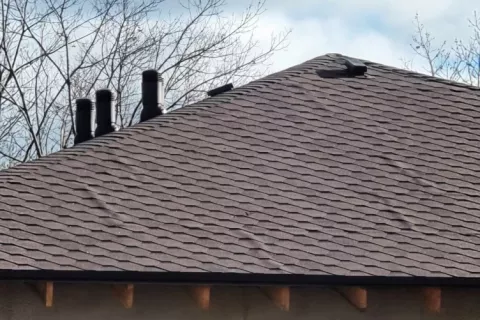Getting a new roof is a significant investment that should provide peace of mind and protection for your home for many years. However, what happens when you notice shingles buckling on your new roof? It can be a disconcerting sight and raise questions about the quality of the installation or the roofing materials used. In this article, we’ll explore the causes of shingles buckling on a new roof and what steps you can take to address the issue.

Understanding Shingles Buckling
Before diving into the causes and solutions, let’s clarify what shingles buckling means. Buckled shingles are those that appear raised or lifted from the surface of the roof, creating unevenness. This can happen in various ways, and understanding the underlying reasons is essential for effective resolution.
Causes of Shingles Buckling on a New Roof
Improper Installation:One of the most common causes of shingles buckling on a new roof is improper installation. This can include errors in nailing, fastening, or aligning the shingles. If the shingles aren’t correctly aligned or fastened, they can buckle over time, especially in areas with extreme weather conditions.
- Inadequate Ventilation:Poor attic ventilation can lead to temperature fluctuations and moisture buildup in the attic space. This can cause the underside of the roof deck to expand and contract, pushing the shingles upwards and leading to buckling.
- Manufacturing Defects:While relatively rare, manufacturing defects in the shingles themselves can also result in buckling. These defects may not become apparent until after installation.
- Incorrect Underlayment:The underlayment is an essential layer beneath the shingles that provides an additional barrier against moisture. If the underlayment is not installed correctly or is of low quality, it can lead to shingle buckling.
Addressing Shingles Buckling: Steps to Take
Inspect the Roof:If you notice shingles buckling on your new roof, the first step is to conduct a thorough inspection. Identify the extent of the problem, noting any areas where buckling is occurring and whether there are any visible signs of damage or defects.
- Consult the Installer or Contractor:If your roof is still under warranty, contact the installer or roofing contractor responsible for the installation. They should assess the issue and determine whether it is covered by the warranty.
- Consider Ventilation Improvements:If inadequate ventilation is identified as the cause, consider improving attic ventilation. Proper ventilation can help regulate temperature and moisture levels, preventing future shingle buckling.
- Address Underlying Issues:If the buckling is due to manufacturing defects or incorrect underlayment, work with your contractor to replace the affected shingles and rectify the underlying issues.
- Monitor for Future Problems:After addressing the buckling issue, continue to monitor your roof’s condition regularly. Promptly address any signs of damage or wear to prevent further problems.
Conclusion
Shingles buckling on a new roof can be concerning, but it’s essential to address the issue promptly and methodically. Identifying the cause, consulting with the installer or contractor, and taking appropriate corrective measures will help ensure the longevity and performance of your new roof. Regular maintenance and vigilance can go a long way in protecting your investment and maintaining the integrity of your home’s roofing system.



Leave a Reply